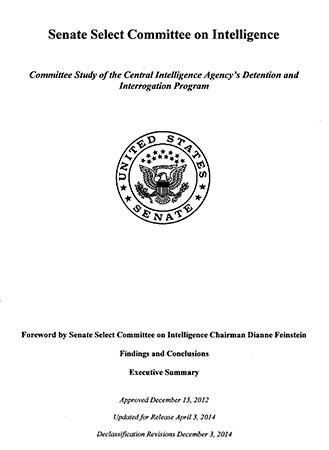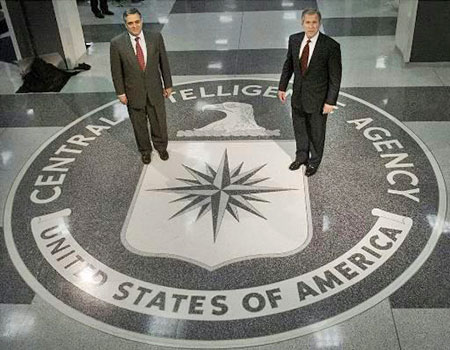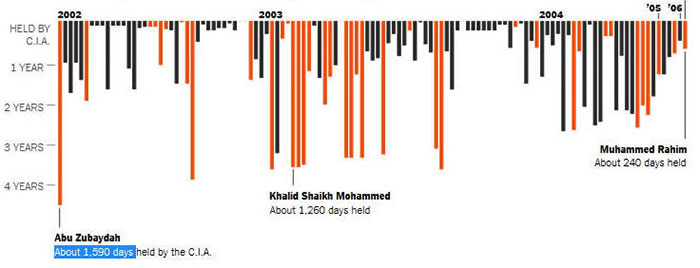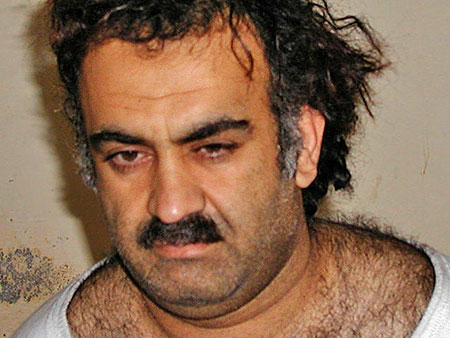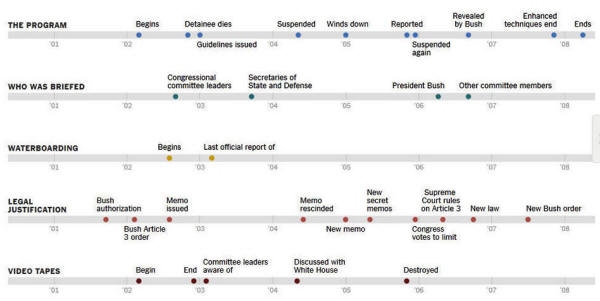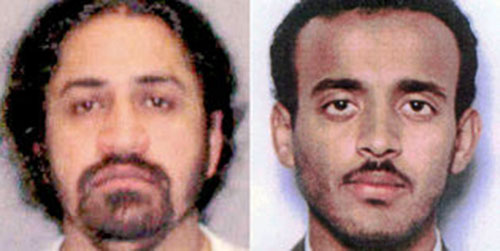|
Matt Apuzzo and Peter Baker contributed reporting.
from
NYTimes Website
Senate Intelligence Committee report on CIA interrogation tactics added a new chapter to the national conversation on the government's use of torture.
WASHINGTON
The Senate Intelligence Committee on
Tuesday issued a sweeping indictment of the Central Intelligence
Agency's program to detain and interrogate terrorism suspects in the
years after
the Sept. 11 attacks, drawing on millions of internal
CIA documents to illuminate practices that it said were more
brutal - and far less effective - than the agency acknowledged
either to Bush administration officials or to the public.
The Senate committee's investigation,
born of what its chairwoman, Senator Dianne Feinstein of California,
said was a need to reckon with the excesses of this war, found that
CIA officials routinely misled the White House and Congress about
the information it obtained, and failed to provide basic oversight
of the secret prisons it established around the world.
With the approval of the CIA's medical staff, some prisoners were subjected to medically unnecessary "rectal feeding" or "rectal hydration" - a technique that the CIA's chief of interrogations described as a way to exert "total control over the detainee."
CIA medical staff
members described the waterboarding of Khalid Shaikh Mohammed, the
chief planner of the Sept. 11 attacks, as a "series of near drownings."
Document The Senate Committee's Report
on the CIA's Use
of Torture
The committee obtained a photograph of a waterboard surrounded by buckets of water at the prison in Afghanistan commonly known as the Salt Pit, a facility where the CIA had claimed that waterboarding was never used.
One clandestine officer described the prison as a "dungeon," and another said that some prisoners there,
The release of the report was severely criticized by current and
former CIA officials, leaving the White House trying to chart a
middle course between denouncing a program that President
Obama
ended during his first week in office, and defending a spy agency he
has championed.
But in a later television interview, he reiterated that the techniques "constituted torture in my mind" and were a betrayal of American values.
George J. Tenet, left, was director of the Central Intelligence Agency when the brutal tactics began.
The report said he
misled President George W. Bush.
The intelligence gleaned during interrogations, he said, was
instrumental both in thwarting terrorism plots and in capturing
senior figures of Al Qaeda.
...
repeatedly inflated the value of the program in secret briefings
both at the White House and on Capitol Hill, and in public speeches.
Graphic:
7 Key Points
From the CIA Torture Report
She said,
As she was preparing to speak, John O. Brennan, the CIA director, issued a response that both acknowledged mistakes and angrily challenged some of the findings of the Senate report as an,
But despite the mistakes, he added,
The report is more than 6,000 pages long, but the committee voted in April to declassify only its 524-page executive summary and a rebuttal by Republican members of the committee.
The investigation was conducted by the committee's Democratic majority and their staffs.
Many of the CIA's most extreme interrogation methods, including waterboarding, were authorized by Justice Department lawyers during the Bush administration.
But the report also found
evidence that a number of detainees had been subjected to other,
unapproved methods while in CIA custody.
Within days of the Justice Department's approval to begin waterboarding the prisoner,
Abu Zubaydah, the sessions became so
extreme that some CIA officers were "to the point of tears and
choking up," and several said they would elect to be transferred out
of the facility if the brutal interrogations continued.
The interrogations lasted for weeks, and some CIA officers began sending messages to the agency's headquarters in Virginia questioning the utility - and the legality - of what they were doing.
But such questions were rejected.
the waterboarding of Khalid Shaikh Mohammed as a "series of near drownings."
Credit Associated Press
The Senate report found that the detention and interrogation of Mr.
Zubaydah and dozens of other prisoners were ineffective in giving
the government "unique" intelligence information that the CIA or
other intelligence agencies could not get from other means.
In late 2008, according to one
internal email, a CIA official giving a briefing expressed
concern about the discrepancy and was told by Mr. Hayden, then the
agency's director, "to keep the number at 98" and not to count any
additional detainees.
Abu Zubaydah's torture moved some CIA officers to tears.
Credit
U.S. Central Command, via Associated Press
Many Republicans have said that the report is an attempt to smear both the CIA and the Bush White House, and that the report cherry-picked information to support a claim that the CIA's detention program yielded no valuable information.
Former CIA
officials have already begun a vigorous public campaign to dispute
the report's findings.
The battle over the report has been waged behind closed doors for years, and provided the backdrop to the more recent fight over the CIA's penetration of a computer network used by committee staff members working on the investigation.
CIA officers came to
suspect that the staff members had improperly obtained an internal
agency review of the detention program over the course of their
investigation, and the officers broke into the network that had been
designated for the committee's use.
Graphic: A History of the CIA's
Secret Interrogation Program
The chief of the agency's
Counterterrorism Center said during a meeting with Mr. Brennan in
April that more than 200 people working for him had at one point
participated in the program.
Such methods might gain wider approval, the lawyers figured, if they were shown to save lives.
and Ramzi bin al-Shibh
were held in secret prisons.
The report describes repeated efforts by the CIA to make that case, even when the facts did not support it.
For example, the CIA
helped edit a speech by Mr. Bush in 2006 to make it seem as if key
intelligence was obtained through the most brutal interrogation
tactics, even when CIA records suggested otherwise.
The two contractors, both
psychologists, are identified in the Senate report under the
pseudonyms Grayson Swigert and Hammond Dunbar.
In
September 2006, Mr. Bush ordered all of the detainees in CIA
custody to be transferred to the prison at Guantánamo Bay, Cuba, and
after that the CIA held a small number of detainees in secret at
a different facility for several months at a time, before they were
also moved to Guantánamo Bay.
The
report chronicles millions of dollars in secret payments between
2002 and 2004 from the CIA to foreign officials, aimed at getting
other governments to agree to host secret prisons.
|

